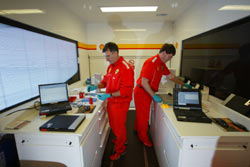Lubricants
The word lubricant is derived from Latin "Lubricus" which means "to glide". A lubricant is therefore a product that reduces friction and eases operation when in contact with moving parts. There are some important functions a lubricant should do and that have to be taken into account when engineering a high performance lubricant:
- Heat transfer: Moving parts contain energy that is transformed to heat because of the friction between them. The warmth should be adequately transferred to keep each part on a constant temperature, and prevent these from heating up and losing strength.
- Reduce friction: Lubrication oils reduce the friction coefficient between two moving parts, and thereby reduce the energy transformed to heat. The less friction, the more energy is maintained to make the wheels rotate.
- Reduce wear: By lowering the friction, mechanical wear is severely reduced. Lubricant engineers should moreover take care of reducing corrosive and 'fatigue de contact' wear.
- Fire resistance: In case of a fire, lubricants should not catch fire of explode, but rather act as an extinguisher.
- Neutrality against elastomers and plastics.
- Cleaning: oils may also act as a cleaning fluid by neutralizing or expelling useless particles.
- Shock absorption and noise reduction.
Usage in Formula One
 Formula One lubricants are, just like fuels, often supplied by a technical partner such as Castrol, Shell, Petrobras, Total, ... . These suppliers produce and develop lubricants without a cost to their team(s). Lubricants are mainly used in gearboxes and engines, where they can greatly improve performance by reducing internal friction. It is therefore highly important for a team to have a close relation with its lubricant supplier to let it produce the best lubricants possible within the FIA's regulations and regarding the car's parts it will be used with. Ferrari chief Jean Todt once stated his lubricant supplier Shell "is part of the team, and will always be". That same supplier is in F1 for Ferrari with a mobile laboratory that is present every grand prix to examine the liquids. The 40 employees (working at Shell F1 in 2004) can this way sometimes find several types of engine wear even before they are visible in the performance.
Formula One lubricants are, just like fuels, often supplied by a technical partner such as Castrol, Shell, Petrobras, Total, ... . These suppliers produce and develop lubricants without a cost to their team(s). Lubricants are mainly used in gearboxes and engines, where they can greatly improve performance by reducing internal friction. It is therefore highly important for a team to have a close relation with its lubricant supplier to let it produce the best lubricants possible within the FIA's regulations and regarding the car's parts it will be used with. Ferrari chief Jean Todt once stated his lubricant supplier Shell "is part of the team, and will always be". That same supplier is in F1 for Ferrari with a mobile laboratory that is present every grand prix to examine the liquids. The 40 employees (working at Shell F1 in 2004) can this way sometimes find several types of engine wear even before they are visible in the performance.
There are necessarily some differences between the products used in Formula One and those sold on the forecourt. Those differences are however only dictated by the vehicles differences and demands. Teams and their petrochemical suppliers develop fuels and oils together that are used exclusively in the Formula One high performance, high revving engine and gearbox. As team engineers continue to improve the car throughout the season, lubricant engineers of the supplier work closely with them, adapting to constantly evolving engine specifications and varying circuit demands.
Analysis of used lubricants
As before mentioned, oil engineers are at every race event with a mobile laboratory where they analyze the used lubricants. The information is recorded by a series of photo multipliers, then displayed by category on screen. The result allows the engine's health to be assessed. Too much iron? It's likely to be a combustion problem. Too much chrome indicates abnormal wear of the piston rings. Excessive copper or tin indicates the big end bearings may be in poor condition.
In order to become great precision of engine diagnostics, manufacturers use spark spectrometry. These analyses allow the engine engineers to take preventative measures. If it's clear that an engine won't last, the team can then decide upon its replacement before it even breaks down. All data collected of the analyzed samples are then stored from which graphs can be generated. This way, lubricant engineers and the team have a precise view of the health of an engine.
